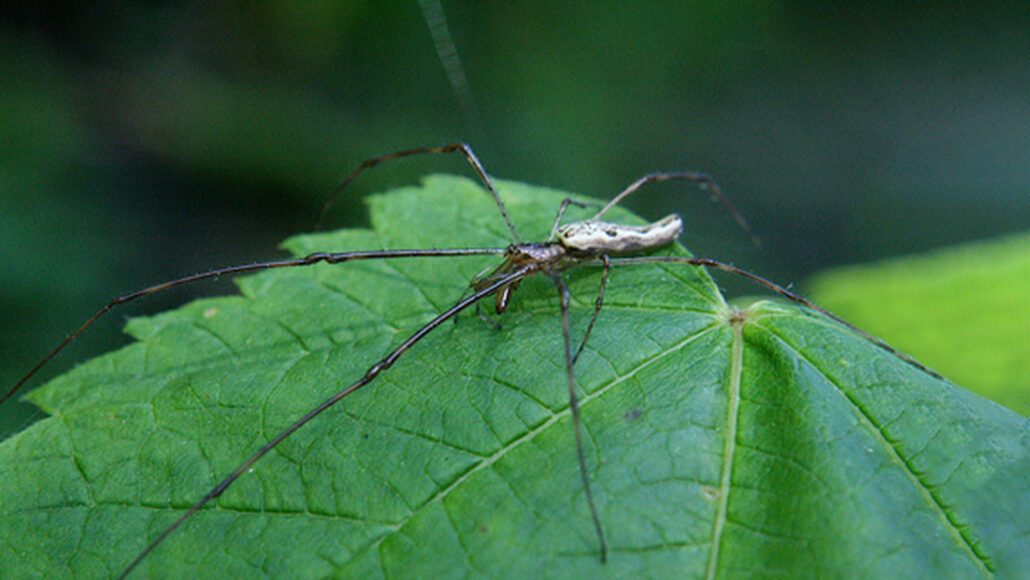Spiders that fall into water use reflected light to find land
When flung into a pond, they head for areas that don’t reflect polarized light

The shore-dwelling elongate stilt spider frequently tumbles into water. But it finds its way back to land by detecting light reflecting off the water, new studies suggest. This one was spotted on a leaf in New York’s Niagara Falls State Park.
Cody Hough (CC BY-SA 3.0)
Share this:
- Share via email (Opens in new window) Email
- Click to share on Facebook (Opens in new window) Facebook
- Click to share on X (Opens in new window) X
- Click to share on Pinterest (Opens in new window) Pinterest
- Click to share on Reddit (Opens in new window) Reddit
- Share to Google Classroom (Opens in new window) Google Classroom
- Click to print (Opens in new window) Print
Spiders really like to hang out in Brian Gall’s kayak. While flinging eight-legged stowaways out of his boat one day, the biologist noticed an interesting pattern. After landing on the water’s surface, these arachnids quickly darted to the nearest shoreline. No matter how far Gall paddled from dry land, they seemed to know which way to go.
The passengers were elongate stilt spiders (Tetragnatha elongata). This species spins webs on the edges of ponds and streams to catch prey. So it’s not unusual for the spiders to tumble into the water. When they do, they rely on surface tension to skitter back to shore. But just how the stilt spiders knew which way to go has been unclear — until now. They appear to use light reflected off the water’s surface. It may help them pinpoint the shoreline, which is less reflective. Gall and his team at Hanover College in Indiana reported this in Zoology, last December.
There are some 51,000 known species of spiders. Scientists have studied the navigation skills of just a few of them. Spiders have been shown to rely on sound, vibrations and chemical signals. Then, of course, there’s their eight eyes, which some species use to see polarized light.
Usually, light waves move in all directions. But they can get flattened together — or polarized — after bouncing off a reflective surface, such as a pond. We see this kind of light as a harsh glare.
“Spider vision is completely different than ours,” says Sidney Goedeker. “And it’s not something that we can perceive, because we don’t have what they have.” Goedeker worked with Gall in college. Now she’s a research technologist at the University of Louisville in Kentucky.
Perhaps, Gall had thought, his spidey stowaways could help him study the elongate stilt spider’s homing senses. To find out, his team built test arenas. One was in an outdoor tank. A pond in Gall’s backyard served as the other.
In some spots, a film they held just above the water polarized incoming sunlight before it hit the surface. That created areas without glare. These spots were meant to mimic what land might look like to a spider. Then, the researchers dropped 68 spiders into the water and recorded the movements of each.
Spiders put in the tank overwhelmingly raced to covered areas. In the pond, spiders were dropped between the shore and the covered areas. They headed for each option with equal frequency, circling the area until they found land. In both arenas, spiders that chose covered areas would often circle in and out of the film’s shadow. They seemed to be searching for the expected shoreline.
Some previous experiments were done in ponds without the film, Gall says. In these, elongate stilt spiders always zipped toward land. The team now concludes the species likely views polarized light to mean “not land.”
“I have dropped probably one thousand spiders onto the water’s surface,” Gall says. “I’ve almost never seen them make the wrong choice.”
There’s still much to learn about how other spiders navigate, says Eileen Hebets. An arachnid biologist at the University of Nebraska–Lincoln, she was not involved in the new study. Its finding “opens up lots of new questions,” she says. “We tend not to think of vision as being very important for web-building spiders.”
Gall is thrilled that this discovery arose from tossing spiders out of his kayak. “It just highlights how watching and asking really basic questions can lead to really cool stuff.”







